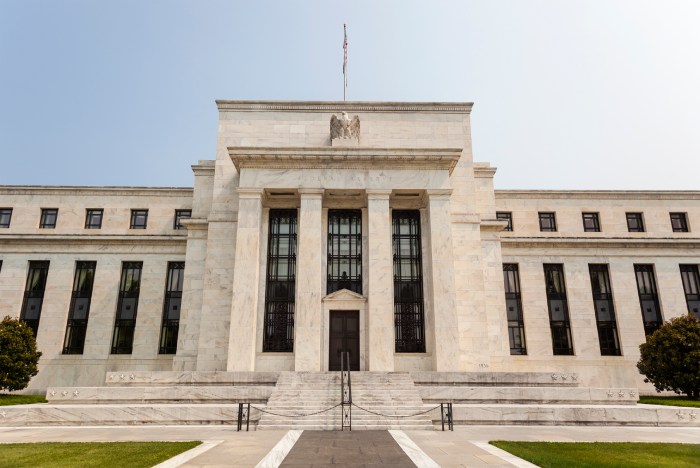Yo, ready to dive into the world of the Federal Reserve? Get ready for a ride filled with knowledge bombs and insights that will blow your mind. From the importance of the Fed to its structure and monetary policies, we’ve got you covered!
Let’s break it down and uncover the mysteries behind the Federal Reserve, one step at a time.
Importance of the Federal Reserve
The Federal Reserve, often referred to as the Fed, plays a critical role in the US economy by overseeing monetary policy, regulating financial institutions, and maintaining economic stability.
Monetary Policy
The Federal Reserve is responsible for setting interest rates and controlling the money supply to achieve economic goals such as full employment and stable prices. By adjusting interest rates, the Fed can influence borrowing, spending, and investment in the economy.
Regulating Financial Institutions
In addition to monetary policy, the Federal Reserve supervises and regulates banks to ensure the safety and soundness of the financial system. This oversight helps prevent financial crises and protects consumers from fraud and abuse.
Economic Stability
One of the key functions of the Federal Reserve is to promote economic stability by monitoring economic indicators, such as inflation and unemployment, and taking action to mitigate potential risks. Through its policies and interventions, the Fed aims to prevent recessions and support sustainable economic growth.
Currency Issuance
Another important role of the Federal Reserve is to issue currency and maintain the integrity of the US dollar. By managing the supply of currency in circulation, the Fed helps ensure the stability of the nation’s currency and the confidence of consumers and investors.
Structure of the Federal Reserve
The Federal Reserve System is structured to carry out its responsibilities effectively and efficiently. Let’s dive into the organizational structure and roles of key components within the Federal Reserve.
Board of Governors vs. Federal Open Market Committee
The Board of Governors, located in Washington, D.C., consists of seven members appointed by the President and confirmed by the Senate. They are responsible for setting monetary policy, supervising and regulating banks, and maintaining the stability of the financial system. On the other hand, the Federal Open Market Committee (FOMC) is made up of the seven members of the Board of Governors, along with five Reserve Bank presidents. The FOMC is responsible for open market operations, which involve buying and selling government securities to influence the money supply and interest rates.
Federal Reserve Banks Operations
Federal Reserve Banks are located in major cities across the U.S. and serve as the operating arms of the Federal Reserve System. They carry out various functions, including clearing checks, distributing currency, and providing banking services to depository institutions. Each Federal Reserve Bank is overseen by a board of directors, which includes representatives from the banking industry, the public, and the government. These banks play a crucial role in implementing monetary policy decisions made by the FOMC and ensuring the smooth functioning of the financial system.
Monetary Policy Tools

Monetary policy tools are essential instruments used by the Federal Reserve to manage the economy and achieve specific goals. These tools help regulate the money supply, interest rates, and overall financial conditions in the country.
Open Market Operations
Open market operations involve buying or selling government securities to influence the amount of money in the banking system. When the Federal Reserve buys securities, it increases the money supply, leading to lower interest rates. Conversely, selling securities reduces the money supply, resulting in higher interest rates.
Discount Rate
The discount rate is the interest rate at which commercial banks borrow reserves directly from the Federal Reserve. By adjusting the discount rate, the Fed can encourage or discourage banks from borrowing money, affecting overall lending and economic activity.
Reserve Requirements
Reserve requirements dictate the minimum amount of funds banks must hold in reserve against deposits. By changing these requirements, the Federal Reserve can influence the amount of money banks can lend out, impacting the overall money supply and economic activity.
Quantitative Easing
Quantitative easing is a monetary policy tool used by central banks, including the Federal Reserve, to stimulate the economy by purchasing financial assets like government bonds. This process increases the money supply and lowers long-term interest rates, making borrowing cheaper and encouraging investment and spending.
Federal Reserve Independence
The concept of Federal Reserve independence refers to the autonomy of the Federal Reserve System to make monetary policy decisions without interference from the government or political influence. This independence is crucial to ensure that the central bank can act in the best interest of the economy as a whole, rather than being swayed by short-term political considerations.
History of Federal Reserve Independence
The Federal Reserve was created in 1913 with the passage of the Federal Reserve Act, which aimed to establish a central bank that could respond to financial crises and stabilize the economy. Over the years, the independence of the Federal Reserve has been reinforced through legislative measures and court rulings to protect it from undue political pressure.
- The Humphrey-Hawkins Act of 1978 mandated that the Federal Reserve pursue specific economic objectives, such as maximum employment and stable prices, without interference from the government.
- In the landmark Supreme Court case, Humphrey’s Executor v. United States (1935), the court ruled that the President cannot remove a Federal Reserve Board member except for cause, further solidifying the independence of the central bank.
Benefits and Drawbacks of Federal Reserve Independence
Maintaining independence allows the Federal Reserve to focus on its dual mandate of promoting maximum employment and stable prices, which are crucial for a healthy economy. It enables the central bank to make decisions based on economic data and analysis rather than political considerations. However, there are also potential drawbacks to this independence, such as a lack of direct accountability to the public or elected officials, which can lead to criticism and calls for increased oversight.
